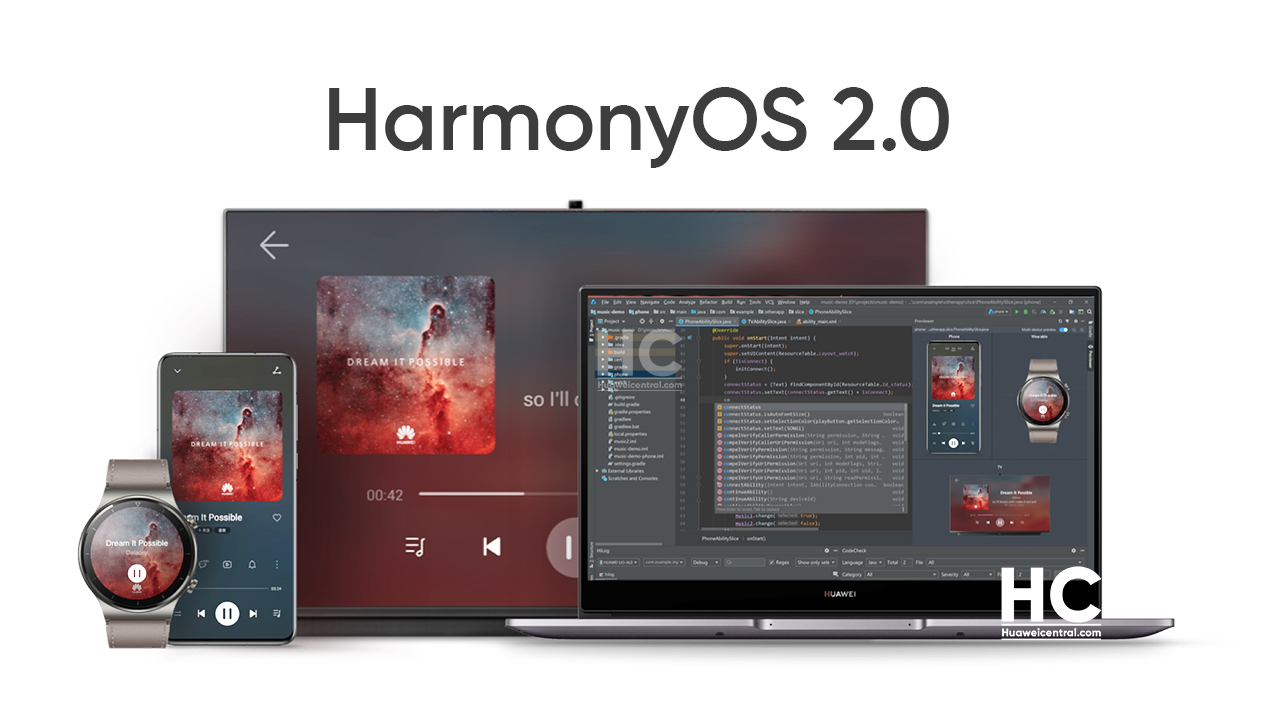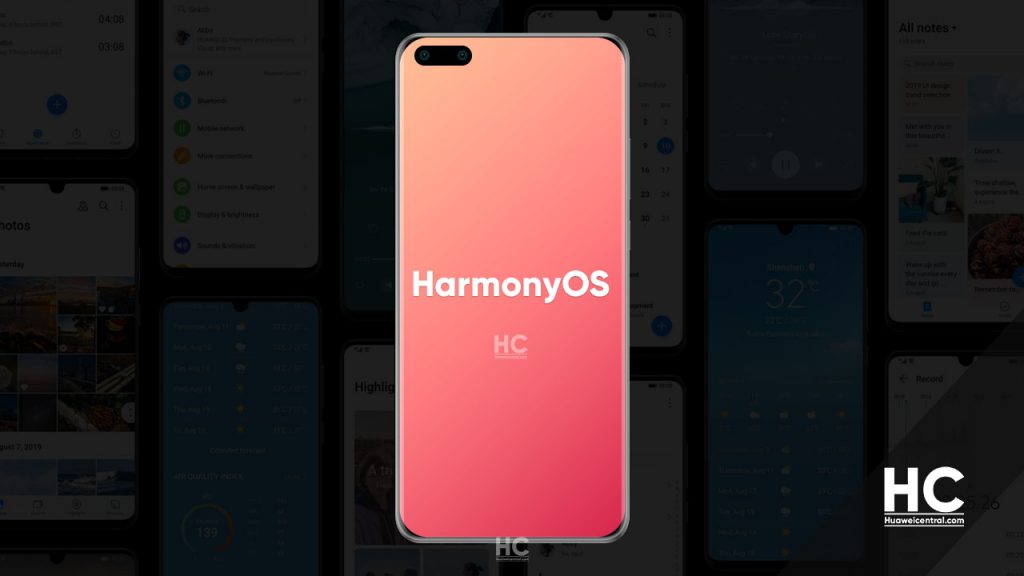HarmonyOS
Huawei released DevEco Studio 2.1 Beta 2 with six major changes for HarmonyOS service development

DevEco is Huawei’s integrated development environment (IDE) that provides templates for developers to create, develop, compile, debug, test, and deploy E2E HarmonyOS application development services.
On December 16, 2020, Huawei released the HarmonyOS 2.0 mobile developer beta version and simultaneously opens the enrollment of some devices for beta testing. With the help of DevEco Studio, developers can more efficiently innovate and develop the application with distributed HarmonyOS open capabilities
Now, Huawei has begun sending the new version for DevEco Studio that brings a number of new features and improvements, which help out developers and enhance the innovation efficiency.
According to the new changes, DevEco Studio 2.1 Beta 2 (Windows+Mac version) has supported the preview of the Java UI interface and the JS UI interface, provides security testing, automation testing, improves the editor capabilities, and more.
In the last update of DevEco Studio 2.0 Beta 1, the company added new support for the Ubuntu platform, NVP, Realtek, Xradio chip, and added HDF driver as well as allows the graphical download of HPM source code.
Related: Huawei DevEco Device Tool 2.0 Beta 1 for HarmonyOS 2.0 released with new features and improvements

New version:
- Huawei DevEco device tool receiving new build 2.0 Beta 2
Changelog:
- Mac version complete Java UI preview
- Added 5 mobile phone project templates
- Visualization of debugging variables for JS and C/C++
- Provide application security testing services
- Provide application automation testing services
- Enhance editor capabilities
Check the changes in detail below:
Mac version complete Java UI preview
DevEco Studio 2.1 Beta 2 (Windows+Mac version) for JS applications, supports six device types: mobile phones, tablets, smart screens, smart wearables, lightweight smart wearables, and smart vision. For Java applications, it supports mobile phones, tablets, and cars, smart screens, and smart wearable devices.
Regarding the JS UI layout, developers can dynamically preview in real-time in the previewer after writing the code in HTML/CSS/JS. The UI display effect is the same as when the application is running on a real machine. For Java UI layout, developers can experience dynamic preview when previewing AbilitySlice.java or Ability.java file and preview XML layout file to experience real-time preview.
In addition, the development of distributed applications must meet the screen resolution, shape, and size requirements of different devices. In order to facilitate developers to view the UI layout and interaction effects of the application on different devices at any time during the application development process, DevEco Studio provides a cross-device preview function.
Added 5 mobile phone project templates
In order to facilitate the use of developers, DevEco Studio 2.0 provides Ability templates for multiple device types and different development languages. It adds 5 new phone project templates on the original basis. Developers can select appropriate templates according to the project wizard, easily create projects suitable for various devices, and automatically generate corresponding Code and resource templates.
Visualization of debugging variables for JS and C/C++
Aiming at pain points such as long code processing flow and deep error concealment, DevEco Studio 2.1 Beta 2 uses Plain (tree), Line (line graph), Bar (bar graph), and Table during JS or C/C++ code debugging. (Table), etc., quickly display the data structure, data continuous change curve, and the relationship between the data during the debugging process, and provide functions such as query filtering and sorting of the visual data, which is convenient for developers to locate problems simply, intuitively, quickly and effectively.
Provide application security testing services
By integrating the capabilities of the Huawei DevEco Services cloud service platform, DevEco Studio 2.1 Beta 2 provides application security testing services for HarmonyOS applications. Currently, it mainly supports two functions: vulnerability testing and privacy testing. For each test task, the test is fully automated without manual intervention, and professional and detailed test reports are issued quickly to detect and identify possible security issues in the application development process in advance so that the developed HarmonyOS application can better meet the application requirements of the market.
Vulnerability testing: Through the HarmonyOS application life cycle modeling and application attack surface modeling, static data flow analysis technology is used to improve the accuracy of vulnerability discovery while covering more than 20 attack surfaces and 65 + vulnerability test items to help developers in advance Discover and identify potential vulnerabilities. The vulnerability detection report will give clear repair suggestions for each vulnerability risk item to help developers quickly repair vulnerabilities. The vulnerability testing service supports Java applications, and the package format includes Hap/App.
Privacy detection: By dynamically detecting and analyzing the privacy-sensitive behavior of the application running on the device, it helps developers to troubleshoot the malicious behavior of the application and build a pure and green HarmonyOS application. The privacy test supports 17 + detections, including detection of obtaining geographic location information, detection of obtaining device identification, detection of obtaining address book information, detection of obtaining system information, etc. The privacy test service currently supports Java applications for TV devices, and the package format includes Hap/App.
Provide application automation testing services
In addition to application security testing services, DevEco Studio 2.1 Beta 2 also adds application automation testing services, including application compatibility, stability, and performance testing, to detect possible applications in the entire life cycle of installation, startup, operation, and uninstallation as well as check the application quality in all directions.
Compatibility test: Mainly verify the compatibility issues of the HarmonyOS application running on Huawei’s real device, including the first installation, reinstallation, startup, uninstallation, crash, black and white screen, flashback, operation error, failure to rollback, and top ten UI abnormalities Abnormal scene. The compatibility test supports Java/JS applications for TV and Lite Wearable devices. The package format supported by TV is Hap/App; the package format supported by LiteWearable is App.
Stability test: Mainly verify the stability issues of the HarmonyOS application running on Huawei’s real device, including crash/application freeze screen, memory leak, and memory stepping. The stability test supports Java/JS applications of TV devices, and the package format includes Hap/App.
Performance test: Mainly verify the performance problems of the HarmonyOS application running on Huawei’s real device, including startup time, interface display, CPU usage, and memory usage. The performance test supports Java/JS applications of TV devices, and the package format includes Hap/App.
Enhanced editor capabilities
Development and application are like building a house. There are many factors that determine the quality of a house, but the foundation is one of the important factors. The editor is to the development tool as the foundation is to the house. A good editor can make developers do more with less. DevEco Studio supports the development of HarmonyOS applications in multiple languages, including Java, JS, and C/C++.
For the C/C++ editor, DevEco Studio 2.1 Beta2 has made four enhancements:
- Enhanced code completion function. In the writing application stage, the editor will analyze the context and understand the content of the project. According to the content entered by the developer, it will prompt the developer to complete the names of classes, methods, fields, and keywords, which greatly improves the coding efficiency.
- For the names and variables of the macro definition, as well as the preprocessing path and prefix, developers are supported to customize the highlight color of their code, which is convenient for developers to distinguish different codes by color.
- Support function jump from definition to the declaration. When the code realizes the jump, the listed results will be distinguished by file name and display key code information.
- Supports viewing of documents of display types, methods, functions, parameters, etc., which is convenient for developers to read the code.
For the JS editor, DevEco Studio 2.1 Beta 2 has made three optimizations:
- The code completion function is enhanced, which is manifested in import optimization, suffix completion, and enhancement of annotation capabilities.
- Code grammar enhancement: support ES6 grammar, Emmet grammar, and Media Query conditional rules to automatically complete.
- Code checking enhancement: duplicate variable and unused variable checking; automatic strikethrough display of referenced obsolete symbols, obsolete symbols can be marked by @deprecated in JS doc comments; support for spell checking of JS, HTML, CSS codes, etc.
For the XML editor, DevEco Studio 2.1 Beta 2 has made two enhancements:
- For the resources in the predefined JSON/XML, it can dynamically associate and jump in real-time.
- In the XML layout file, use the <databind> tag to realize the dynamic data binding function between java and XML.
For the Java editor:
DevEco Studio 2.1 Beta 2 can modify the references in the config.json configuration file when reconstructing the project directory structure or Java class names. After many optimizations, the editor function of DevEco Studio 2.1 Beta 2 is becoming more and more perfect. The majority of developers can improve coding efficiency by mastering various common skills in code writing during the application phase.
In addition to the above six functions, DevEco Studio 2.1 Beta 2 also solves three major user pain points:
- Solved the problem of slow Gradle download during project synchronization. The new version integrates the Gradle tool so that developers no longer need to download the Gradle tool separately.
- Added to view the preview log, you can view the log information during the preview process, and also support the switch between Chinese and English.
- Solved the problem that the simulator does not support the display of the WebView control.
[Via- ithome]







